Leighton Buzzard Light Railway
The Leighton Buzzard Light Railway (LBLR) is a light railway in Leighton Buzzard in Bedfordshire, England. It operates on 2 ft (610 mm) narrow-gauge track and is just under 3 miles (4.8 km) long. The line was built after the First World War to serve sand quarries north of the town. In the late 1960s the quarries switched to road transport and the railway was taken over by volunteers, who now run the line as a heritage railway.
| Leighton Buzzard Light Railway | |
|---|---|
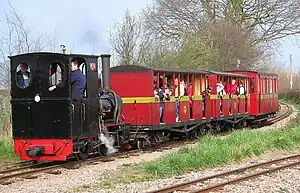 A train on the LBLR being pulled by No. 11 PC Allen | |
| Locale | England |
| Terminus | Page's Park, Leighton Buzzard |
| Commercial operations | |
| Name | Leighton Buzzard Light Railway |
| Built by | A.J. Arnold and G. Garside |
| Original gauge | 2 ft (610 mm) |
| Preserved operations | |
| Operated by | Leighton Buzzard Narrow Gauge Railway Society |
| Stations | 2 |
| Length | 3 miles (4.8 km) |
| Preserved gauge | 2 ft (610 mm) |
| Commercial history | |
| Opened | 1919 |
| Closed | 1969 |
| Preservation history | |
| 1968 | First passenger trains run by preservation society |
History
Sand extraction
A bed of Lower Cretaceous sand across Bedfordshire has been quarried on a small scale for centuries. The most significant occur around Leighton Buzzard. In the 19th century sand was carried by horse carts from quarries south of the town to be shipped on the Dunstable-Leighton Buzzard railway. The carts damaged roads and resulted in claims for compensation against the quarry owners from Bedfordshire County Council. At the end of the century steam wagons were introduced which increased the damage to roads.
The outbreak of the First World War cut off supplies of foundry sand from Belgium. Sand was needed for ammunition factories and new sources were sought. Leighton Buzzard sands proved well suited and production increased. After 1919 the quarry companies were told they could no longer transport sand by roads, so a private industrial railway was proposed to take the traffic.
The original railway
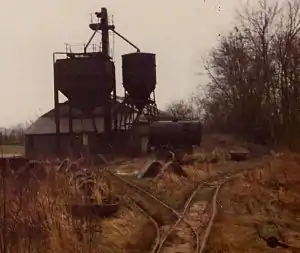
Leighton Buzzard Light Railway opened on Thursday 20 November 1919, linking the sand quarries (Double Arches at the far end of the line) with the mainline railway south of the town at Grovebury sidings. The line was built using surplus equipment from the War Department Light Railways. The railway was built to a gauge of 2 ft (610 mm) and laid using mostly 30 lb/yd (14.9 kg/m) rail. The line opened using steam traction by two Hudswell Clarke 0-6-0 side tank steam locomotives. These proved inappropriate for the tightly-curved line and the steam locomotives were sold in 1921. From that point the railway was run using internal combustion, almost exclusively the products of the Motor Rail company. It was one of the first railways in Britain entirely operated by internal combustion.
After the Second World War sand traffic returned to the roads. In 1953 a strike on mainline railways pushed more traffic onto the roads. By the mid-1960s only one sand quarry, Arnold's, still used the light railway. The BR line to Dunstable was closed in 1965, apart from a short stretch from Leighton Buzzard to Grovebury interchange sidings, which survived until 1969.
The preservation era
In 1968 the line was more lightly used and volunteers under the name of "The Iron Horse Railway Preservation Society" took over the line on weekends to run the first formal passenger services on the line. Part of the agreement between the railway and the volunteers was that volunteers would repair the permanent way. This was undertaken, the group having purchased secondhand rolling stock and four Simplex diesels from the St Albans Sand and Gravel company, which were dismantled and formed into one machine. The last sand train ran on the main line in 1969, although several quarries continued to use the lines within their quarries. These were eventually replaced by roads and conveyor belts and the last internal quarry line was abandoned in 1981. Today the line is run purely as a heritage railway.
A large collection of steam and internal combustion locomotives run on the line. Visitors can ride the train and are issued with an Edmondson ticket. There is a collection of industrial railway locomotives at Stonehenge Works towards the northern end of the line.
The railway is promoted by the Campaign to Protect Rural England.[1]
The route
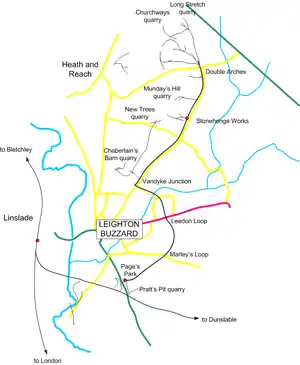
The line is unusual as it runs mostly through modern housing built since the 1970s, although the last half mile runs through countryside. There are open level crossings for which trains stop.
The railway began at Grovebury Sidings, where sand trains unloaded into washers and the sand was shipped to standard-gauge trains on the Dunstable branch or to road. The sidings and industrial plant at Grovebury were replaced with an industrial estate in the early 1970s.
Trains from Grovebury crossed Billington Road by a level crossing and worked up a steep grade to Page's Park. Here a branch line south connected to the line's main engineering workshop and the Pratt's Pit quarry. In 2006 Page's Park forms the southern terminus of the heritage railway.
From Page's Park the line curves north towards a summit at Red Barn. From there it descends at 1 in 60 (1.7%) before climbing again to cross Stanbridge Road. On the left is the site of Marley's Tile Works, now a housing estate, which was connected to the railway for most of its existence. The line descends Marley's Bank at a maximum of 1 in 25 (4%). Loaded sand trains to Grovebury Sidings often needed a banking locomotive.
At the bottom of Marley's Bank the line turns sharply north and runs along the level to Leedon Loop. The line here passes through housing. After Leedon, the railway crosses Hockliffe Road and crosses the Clipstone Brook and begins to climb again on a 1 in 50 (2%) gradient to cross Vandyke Road.
Immediately after crossing Vandyke Road the line curves 90 degrees to Vandyke Junction where there was a passing loop. Here the branch line from Chamberlain's Barn and New Trees quarries joined the main line. A short section of this branch remains intact although heritage trains do not use it. The railway then runs parallel to Vandyke Road, climbing steadily to Bryan's Loop then descending again to cross the Shenley Hill Road. The line levels and continues to Stonehenge Works now the engineering workshop of the preserved railway. This is also the northern terminus of modern operations.
From Stonehenge the line continues northwards with a 1 mile (1.6 km) of double track, climbing towards the two Double Arches sand quarries, owned by Joseph Arnold and George Garside.
Preserved locomotives
These are the locomotives on the preserved railway. All are 2 ft (610 mm) gauge nominally, except where noted.
Steam locomotives
| No. | Name | Wheel Type | Builder | Works No. | Year Built | Origin | Livery | Notes | Image |
|---|---|---|---|---|---|---|---|---|---|
| 1 | Chaloner | 0-4-0VBT | De Winton | n/a | 1877 | Penyrorsedd slate quarry, north Wales | Lined black | Worked at the Penybryn quarry until 1881 then Penyrorsedd until 1960. Purchased by Alfred Fisher and transferred to Leighton Buzzard in 1968. Too small for regular use but used on gala days. Undergoing major overhaul which will require a new boiler. | 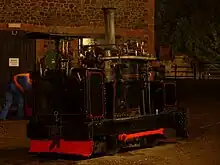 |
| 2 | Pixie | 0-4-0ST | Kerr Stuart | 4260 | 1922 | Devon County Council, Wilminstone Quarry | Lined green | One of 27 of the Wren class ordered for a sewer contract in Essex, sold to Devon County Council in 1929. Purchased by the Industrial Locomotive Society in 1957; entered service at Leighton Buzzard in 1969. Has previously been on loan at the Devon Railway Centre and has now returned to LBNGR. Can be seen running on gala days but as of 2017 is currently undergoing overhaul. | 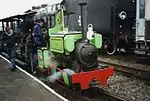 |
| 3 | Rishra | 0-4-0T | Baguley cars Ltd. | 2007 | 1921 | Hoogly Docking & Engineering Co., Rishra, India | Lined green | The only remaining locomotive of this type. Spent all of its working life in Calcutta, where it shunted coal wagons at a water pumping station. Purchased by Mike Satow in 1963 and repatriated to Leighton Buzzard. Entered service in 1971. Too small for regular use and only used on gala days. Operational as of 2017. | 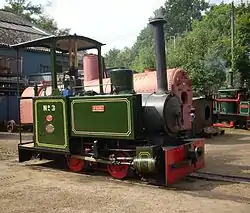 |
| 4 | Doll | 0-6-0T | Andrew Barclay | 1641 | 1919 | Sydenham Ironstone Quarry, King's Sutton, Oxfordshire | Lined blue | Transferred in 1926 to Bilston Furnaces where it ran until 1960. Purchased by the Bressingham Steam Museum in 1966; sold to Henry Williams in 1969; purchased by Leighton Buzzard Light Railway in 1972. A major overhaul which involved the construction of a new boiler, was completed in 2004 and the locomotive was used regularly on passenger trains. Returned to service in 2017 after a ten-yearly overhaul. | 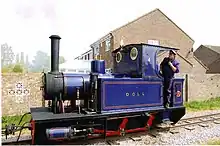 |
| 5 | Elf | 0-6-0WT | Orenstein & Koppel | 12740 | 1936 | Likomba Development Company, Cameroon, Africa | Lined umber | Purchased in 1973 after serving on plantation railways in Cameroon until 1971. Wood-burning with a spark arrestor. Now converted to coal. Stored awaiting overhaul. | |
| 11 | PC Allen | 0-4-0WT | Orenstein & Koppel | 5834 | 1913 | Solvay Alkali Works, Torrelavega, Spain | Unlined green and black | Was originally built for the internal railway system at the chemical works of Solvay & Cie, Torrelavega, Spain. Purchased by Sir Peter Allen in 1963, transferred to Leighton Buzzard in 1970. Returned to service in 2014 following a major overhaul but now withdrawn requiring boiler repairs. | .jpg.webp) |
| 9 | Peter Pan | 0-4-0ST | Kerr Stuart | 4256 | 1922 | Devon County Council, Willminstone Quarry, Devon | Unlined green | Wren class locomotive that worked with Pixie in Devon. Purchased in 1972 by Graham Hall who found the locomotive in a garden in Bromsgrove. | |
| 778 | 4-6-0PT | Baldwin Locomotive Works | 44656 | 1917 | War Department Light Railways | Unlined black | Baldwin Class 10-12-D. One of 495 locomotives built by Baldwin in 1917, for the UK War Department Light Railways. They operated on the thousands of miles of narrow-gauge tracks that supplied the front line trenches in the First World War. It then worked in India until the 1980s, finishing at the Upper India Sugar Mills in Uttar Pradesh. Entered service in August 2007 and is regularly used on passenger trains. The completion of the restoration made 778 the first locomotive of this type to operate in Britain since 1950. | _LBNGR_3.23.jpg.webp) | |
| 4 | Sezela | 0-4-0T | Avonside Engine Company | 1738 | 1915 | Sezela sugar-cane plantation, Natal, South Africa | Unlined green | Built for the 125 mile line that served the Sezela sugar-cane plantation in Natal, South Africa. Returned to service after overhaul in 2019. | .jpeg.webp) |
| Gertrude | 0-6-0T | Andrew Barclay | 1578 | 1918 | Sydenham Ironstone Quarry, King's Sutton, Oxfordshire | Lined red | Transferred in 1926 to Bilston Furnaces where it ran until 1960 with classmate Doll. It steamed for the first time in preservation at the Welsh Highland Heritage Railway in 2010. She remained there until 2019 where she moved to the Leighton Buzzard Railway. She is undergoing overhaul to be returned to operational condition. | 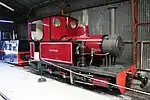 | |
| 2023 | 0-8-0T | Krauss | 7455 | 1918 | First World War service in the German Army | Unlined grey | One of 2500 of this design to be built to serve the German Army in World War I. Following the war it was used on the sugar-beet railway at Maizy in northern France. Finally, it moved to a sand quarry in Variscourt in 1964 before being acquired for preservation in 1970. Acquired by the Leighton Buzzard Railway in 2014 and is awaiting restoration to full working order. |  | |
| Pedemoura | 0-6-0WT | Orenstein & Koppel | 10808 | 1922 | Douro Valley coal mines, northern Portugal | Lined green | Is one size larger than Elf and is a powerful locomotive. After operating for the Douro Valley coal mines in northern Portugal, it was shipped over to the UK in the 1970s for preservation. Following an extensive restoration, the locomotive re-entered service for the first time in over 50 years in July 2016.[2][3] | 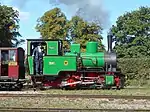 | |
| Nutty | 4wVBT | Sentinel Waggon Works | 7701 | 1929 | Fletton Brickworks | Yellow | 2 ft 6 in (762 mm) |  | |
| Penlee | 0-4-0WT | Freudenstein | 73 | 1901 | Red | Rebuilt by ARC c1983[4] |  | ||
| Elidir | 0-4-0T | Avonside | 2071 | 1933 | [4] | ||||
| 0-4-0WT | Orenstein & Koppel | 2544 | 1907 | [4] |
Internal combustion locomotives
| No. | Name | Type | Builder | Works No. | Year Built | Origin | Livery | Notes | Image |
|---|---|---|---|---|---|---|---|---|---|
| (1) | 4wDM | Motor Rail | 5612 | 1931 | St Albans Sand and Gravel Co. Ltd. Nazeing, Essex | Dismantled by 1988. Restored and returned to service to celebrate the 100th anniversary in 2019. | |||
| (2) | 4wDM | Motor Rail | 5608 | 1931 | St Albans Sand and Gravel Co. Ltd. Smallford, Hertfordshire | Converted to a brakevan, c. 1970 | |||
| (3) | 4wDM | Motor Rail | 5613 | 1931 | St Albans Sand and Gravel Co. Ltd. Smallford, Hertfordshire | Converted to a crane, c. 1970 | |||
| 7 | Falcon (Pam until c. 1978) | 4wDM | Orenstein & Koppel | 8986 | unknown | Woodham Brick Co. Ltd., Wotton, Buckinghamshire | Blue | Only surviving member of the MD2 class in Britain. Rescued from a Newport Pagnell scrapyard in 1970 by Peter Hodges. | |
| 8 | Gollum | 4wDM | Ruston Hornsby | 217999 | 1942 | Featherby's Brickworks, Rochford, Essex | |||
| 9 | Madge | 4wDM | Orenstein & Koppel | 7600 | 1935 | Oxstead Grestone Lime Co. Ltd., Oxstead, Surrey | Single cylinder RL1C class | ||
| 10 | Haydn Taylor | 4wDM | Motor Rail | 7956 | 1945 | British Industrial Sand Ltd. Middelton Towers, Norfolk | Originally loaned by its owners in 1971. Nicknamed "Breadbin" due to its unusual cab shape. Rebuilt in 1973 with a conventional cab. | ||
| 12 | Carbon | 4wPM | Motor Rail | 6012 | 1930 | Standard Bottle Co., New Southgate, Middlesex | Arrived in 1972 via M.E. Engineering, Cricklewood. | ||
| 13 | Arkle | 4wDM | Motor Rail | 7108 | 1937 | George Garside, Leighton Buzzard, Bedfordshire | Original Leighton Buzzard sand quarry loco, operated until 1981 |  | |
| (14) | 4wDM | Hunslet | 3646 | 1946 | Crumbles Gravel Pits, Eastbourne, Sussex | Arrived 1972 | |||
| 15 | Tom Bombadil (after 1990) | 4wDM | F.C. Hibberd | 2415 | 1941 | Butterley & Blaby Brick Companies Ltd., Ripley, Derbyshire | |||
| 16 | Thorin Oakenshield | 4wPM | Lister | 11221 | 1939 | Guard Bridge Paper Co. Ltd., Leuchars, Fife | |||
| 17 | Damredub | 4wPM | Motor Rail | 7036 | 1936 | George Garside, Leighton Buzzard, Bedfordshire | Original Leighton Buzzard sand quarry loco, operated until 1981 | ||
| 18 | Fëanor | 4wDM | Motor Rail | 11003 | 1956 | British Industrial Sands Ltd., Middleton Towers, Norfolk | Dark Maroon | 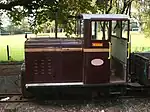 | |
| 19 | 4wDM | Motor Rail | 11298 | 1965 | British Industrial Sands Ltd., Middleton Towers, Norfolk | ||||
| 20 | 4wDM | Motor Rail | 60S317 | 1966 | British Industrial Sands Ltd., Middleton Towers, Norfolk | ||||
| 21 | Festoon | 4wPM | Motor Rail | 4570 | 1929 | George Garside, Leighton Buzzard, Bedfordshire | Original Leighton Buzzard sand quarry loco, preserved 1981 | ||
| 22 | Fingolfin | 4wDM | LBLR | 1 | 1989 | Constructed from parts of Ruston Hornsby 425798 and 444207 | |||
| 23 | 4wDM | Ruston Hornsby | 164346 | 1932 | West Kent Main Sewage Board, Littlebrook, Kent | Second oldest Ruston Hornsby locomotive in existence | |||
| 24 | 4wDM | Motor Rail | 11297 | 1965 | British Industrial Sands Ltd., Middleton Towers, Norfolk | ||||
| (34) | RED RUM | 4wDM | Motor Rail | 7105 | 1936 | Red | 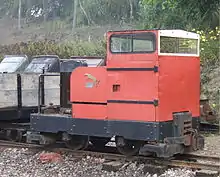 | ||
| 36 | Caravan | 4wDM | Motor Rail | 7129 | 1938 | Redland Flettons Brick Company | Yellow | An unusual variant of the Motor Rail Simplex class with an overall cab. |  |
| (40) | TRENT | 4wDM | Ruston & Hornsby | 283507 | 1949 | Blue | 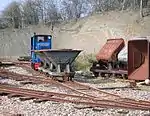 | ||
| 43 | 4wDM | Motor Rail | 10409 | 1954 | Leighton Buzzard Light Railway Company, Leighton Buzzard, Bedfordshire | Original LBLR mainline locomotive; purchased by John Cohring in 1972 | |||
| NG46 | 4wDH | Baguley-Drewry | 3698 | 1973 | [4] | ||||
| NG51 "River Sark" | 4wDH | Barclay | 720 | 1987 | Eastriggs Munitions Factory, Dumfries-Shire, Scotland. | Arrived 2022. visited the FR for the 1995 Gala. Nameplates currently removed. | |||
| 81 | PETER WOOD | 4wDH | Hunslet | 9347 | 1994 | [4] | .jpg.webp) |
Electric Locomotives
| No. | Name | Type | Builder | Works No. | Year Built | Origin | Livery | Notes | Image |
|---|---|---|---|---|---|---|---|---|---|
| NG23 | 4wBE | Baguley-Drewry | 3702 | 1973 | Rebuilt by Andrew Barclay 1987[4] |  |
Previous resident locomotives


| No. | Name | Wheel Type | Builder | Works No. | Year Built | Origin | Notes |
|---|---|---|---|---|---|---|---|
| (1) | |||||||
| 6 | Alice | 0-4-0ST | Hunslet | 780 | 1902 | Dinorwic slate quarry | Now running at the Bala Lake Railway |
| (24) | 4wPM | Motor Rail | 4805 | 1934 | J. Arnold & Sons Ltd., Leighton Buzzard, Bedfordshire | Original Leighton Buzzard sand quarry loco, dismantled by 1980 | |
| 740 | 0-6-0PT | Orenstein & Koppel | 2343 | 1907 | Matheran Light Railway, Maharashtra, India | Restored to working order, has rare Klein-Linder radial axles. She first worked at Leighton Buzzard on 7 September 2002. |
Visiting locomotives

Notable visitors
On 22 June 2013, John Travolta visited the railway with his son Benjamin.[7]
See also
References
- Leleux, Sydney (1996). The Leighton Buzzard Light Railway (2nd ed.). The Oakwood Press. ISBN 0-85361-460-1.
- Hughes D.N.R.; et al. (1974). Leighton Buzzard Narrow Gauge Railway Guide. Leighton Buzzard Narrow Gauge Railway Society Ltd.
- Members Guide 2012, published by CPRE, 2012
- Creagh, Bev (20 July 2016). "Buzzrail's latest baby steams into town". Leighton Buzzard Observer.
- smugmug.com/Trains/2016/Summer
- Industrial Locomotives: including preserved and minor railway locomotives. Vol. 17EL. Melton Mowbray: Industrial Railway Society. 2015. ISBN 978 1 901556 88 9.
- "Latest news". www.btinternet.com. Archived from the original on 22 October 2012. Retrieved 13 January 2022.
- "Archived copy". Archived from the original on 7 January 2005. Retrieved 14 June 2009.
{{cite web}}: CS1 maint: archived copy as title (link) - "John Travolta visits Leighton Buzzard Railway with son". BBC News. 27 June 2013. Retrieved 30 May 2020.